💮 Japanese self-study resources
Table of Contents
Let’s learn Japanese!
Do you want to learn Japanese on your own but have no idea how to even get started? Here is what I did to teach myself Japanese starting in my mid-20s (i.e. after I graduated and had already entered the work force and was learning in my spare time). It’s not the perfect method because only you can find out what works best for you, but this at least should be a good starting place!
Step 1: Get Anki
I wrote a whole guide about it!
Step 2: Learn hiragana/katakana
Get off of romaji immediately. The way I did this was get a lot of notebooks and practice writing out the characters over and over, then start writing vocabulary using hiragana and katakana instead of romaji, and then work your way up to sentences and dialogues. The sooner you wean yourself off of using and thinking in romaji, the easier it will be to look stuff up and understand how onyomi and kunyomi readings work. If you need a quick chart and some printable worksheets, NHK’s got some for free online.
Step 3: Learn to sightread kanji characters by identifying radicals
I can only speak for myself, but the most demoralizing part of learning Japanese was seeing a big block o’ kanji. My mind would shut down because I could not even begin to pick apart what I was looking at. It’s a bit like trying to learn English by memorizing the shapes of whole words instead of first learning the alphabet.
I personally used James Heisig’s Remembering the Kanji, Volume 1. You can get the fifth edition on the Internet Archive.
The idea is to be able to recognize the different radicals of a character, give them a mnemonic keyword, and then make stories for the character using those radicals. So for example: a KING 王 under a ROOF 宀 holding a jewel that looks like a tear-DROP 丶 that is his TREASURE 宝.
If you go with RTK, I also recommend using Kanji Koohii to look up other user-made mnemonics. However, BIG WARNING that some of the stories there can be gross, racist, misogynistic, etc. 💀 This is the hazard of looking through user-submitted content. But if you can stomach it, they can give you hints on what mnemonic story to make if you’re stuck on thinking of one for yourself.
If you do go with RTK, DO NOT GET THE SECOND VOLUME, and instead learn vocabulary and onyomi/kunyomi readings elsewhere. I used the Kanji in Context textbook and its two workbooks in tandem with RTK1 and highly recommend that instead. This gives you vocab and example sentences for each kanji character, and is perfect for inputting into Anki.
If you are on Android, I highly recommend Chase Colburn’s Kanji app. It’s not free and the add-ons are kind of pricey (although in my opinion, you only really need the Self-Study Upgrade, plus the Guided Study add-on if you don’t want to make your own kanji practice cards in Anki) but it’s super worth it. The Kanji Study app lets you organize characters in order of both RTK and Kanji in Context, making it an excellent companion app if you plan to study with those. (It also does this for the Kodansha Kanji Learner’s Course, see below.)
Other options besides RTK
Even though I really love RTK, it can be a bit clunky and DIY to find or make all these notes yourself. There are a few all-in-one options if you’d rather just have everything made so you can dive straight into studying.
- WaniKani uses the same basic idea of radicals and telling mnemonic stories, plus onyomi/kunyomi and vocab. This has a subscription but I’ve had friends tell me it’s worth it to have everything pre-made and digital.
- The Kodansha Kanji Learner’s Course is a series of textbooks that, like RTK, uses radicals and storytelling to remember characters, plus comes with graded readers. And as mentioned, the Kanji Study app lets you organize kanji in the order you learn them in the KLC, so I highly recommend getting that as a companion app for your Android phone.
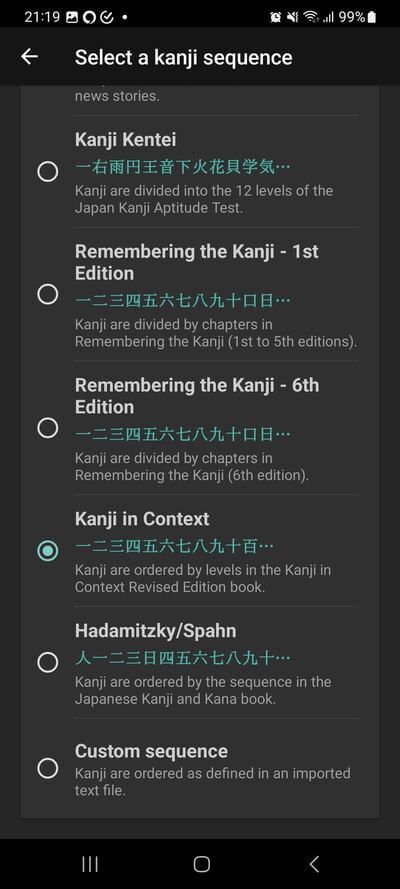
In the Kanji app, you can set your kanji order for JLPT, Kanji Kentei, Remembering the Kanji, Kanji's Learner's Course, Kanji in Context, and others.
IMPORTANT POINT: Whether you go with RTK, WaniKani, or KLC, choose one and stick with it. I don’t recommend changing partway through because you feel it’s too slow or you’re falling behind on your backlog. They all use slightly different mnemonics so rather than confuse yourself (and resetting all of your progress) I recommend not caring too much about having a large backlog and just tackle however much you can, when you can. The important thing is regular review, not Backlog Zero.
Why learn kanji radicals before Japanese?
As I mentioned above, trying to learn Japanese without being able to mentally break apart each kanji character into their radicals is like trying to read English words before learning the alphabet. You can do it, but it’s a LOT harder to look up words you don’t already know, and requires you to memorize what every single English word looks like, rather than just the 26 letters and how they combine together.
The above methods are to help you:
- Learn the “alphabet,” i.e. the different radicals of a kanji so that you can use them to look them up in your kanji dictionary of choice if you run into a character you don’t already know
- Be able to visually pick apart that, for example, 雲 雪 and 雷 are all different characters but probably have something to do with “weather,” and most importantly,
- Sightread this stuff very quickly so that you’re not having to stop and think with every. single. kanji. on. the. page.
Getting your Japanese reading speed up to roughly your L1 reading speed is a really good feeling, and for me personally, that makes me excited to read more stuff!
Step 4: Load up on everything else
You learn vocabulary by seeing them in sentences, and reading sentences helps you understand grammar, and reading lots of sentences increases your reading comprehension, and that helps improves your kanji sight-reading, so on and so forth. This is the step you will be at for the rest of your language-learning journey. Just get your hands on as much Japanese material as you can and practice every day.
Just starting out
I liked the Genki series (textbook and workbook) even though it’s geared for classroom settings, so there are A/B exercises that assume you’re doing them with a partner. If you don’t mind that or can find someone to study with you, they’re a solid entry point. Genki has English explanations for almost everything, if that’s something you think you’d need.
I know the みんなの日本語 Minna no Nihongo series is pretty popular as well. I personally haven’t used these, but a lot of folks swear by them because of just how much stuff gets covered here. The one downside for those starting out is that this series is completely in Japanese, including grammatical explanations and such.
And finally, I cannot recommend Tae Kim’s Japanese grammar guide highly enough. It’s all online, has very clear English explanations, and is completely free.
Studying for JLPT
I used the 新完全マスター Shin Kanzen Master series, though just like with Minna no Nihongo, all of the text is in Japanese (including explanations) so it can be a pretty steep for beginners. I recommend only getting the Grammar 文法 and Reading 読解 books and skipping Vocab and Kanji, and only get Listening if you plan to actually take JLPT.
If you prefer English explanations for stuff and/or want LOTS of additional practice questions, I really like the JLPT “Best” series of books by the Japan Times. Specifically, the Best Practice Tests for the JLPT textbook and workbook.
If you want to see what the different JLPT levels are like, you can’t go wrong with the official test books that are basically tests from previous years.
I also quite like the Ask series of JLPT vocab books as a nice vocab supplement. Handy pocket size, comes with English explanations for everything, and has audio files that you can throw into your Anki decks. They also have a site where you can download PDFs of vocab quizzes.
Beyond textbooks and tests
Dictionaries
These days I mostly study by reading manga and news sites, and writing down stuff I don’t understand to look up later. If you’re on Android, the Takoboto dictionary app lets you make lists of vocab and then export them all into Ankidroid, so it’s super helpful for adding lots of notes when I am away from my computer.
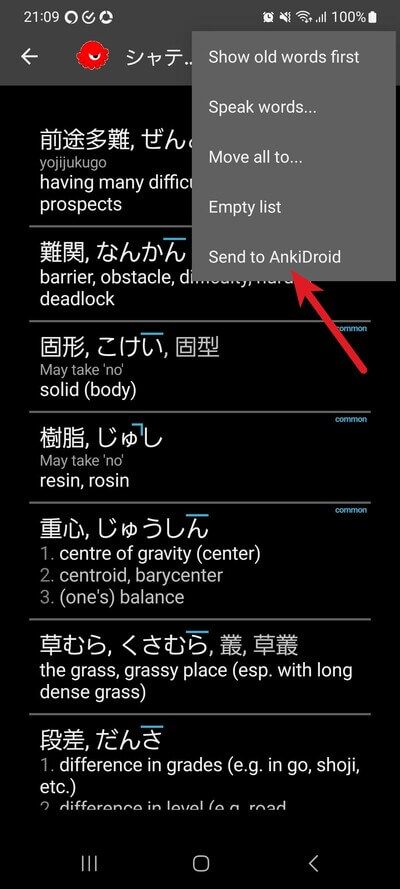
I like to make lists of vocab I look up for books, and then export them all to Anki to study later.
If you don’t want to download a dictionary app and just want to look up words in your browser, I prefer Jisho.org over Takoboto’s website. I believe they both pull from the same J-E dictionaries, but Jisho.org lets you look up kanji characters by radicals, enter in handwriting, and has some other nice features.
If you’re looking for a JP-JP dictionary, I quite like Obunsha’s 標準国語辞典 (Standard Japanese Dictionary). It was around ¥3000 (~$20 as of this writing) and it came with a serial code that I entered into the Obunsha app on my phone to get the digital version as well. Not a bad deal! You can also just buy the digital version of the dictionary within the app itself. I like this dictionary app because you can blow the text up huge and it also links to related entries.
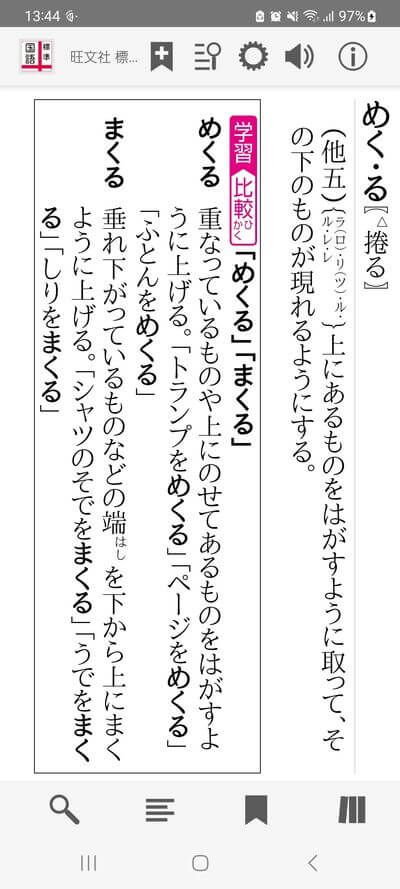
Read more Japanese
NHK Easy News has new articles every weekday in やさしい Easy Japanese. You can toggle furigana on/off and listen to audio of a real human (not a TTS robot voice!) read the article to you.
For manga, I highly recommend slice-of-life or yonkoma (four-panel) series with furigana, though honestly whatever series you like will be great. It helps SO MUCH if you are interested in whatever you are reading, and in my experience, manga and light novels are better at motivating me to study than textbooks and the news. (If someone tries to give you trouble for studying with manga and anime because you’ll learn ““weird”” Japanese, please tell them that this is literally how Japanese kids learn the language 🤷) If you want some recs, I have a list of some manga I’ve enjoyed with notes on if they have furigana or not.
Graded readers
I personally have not used these because they’re pretty hard to find in Japan (or at least, harder than just buying a lot of used manga from Book Off). But my friends swear by them and they are a good way to get started reading whole stories in Japanese. The two that my friends talk about a lot are White Rabbit Press (mobile app) and Tadoku (both print and digital, some are free).
Listen to more Japanese
As for listening practice, the world is your oyster! Anime and J-dramas are wonderful (again, slice-of-life stuff is great for this and is a popular genre, so you have a wealth of options). One of the first shows I latched onto when moving here was NHK’s あさどら asadora (“morning drama,” a ~15min drama that plays every weekday morning). The acting is really hammy which doesn’t make for especially riveting television or anything, but it does mean I can pretty clearly hear what everyone is saying and can pick up from context what’s going on.
There are tons of Japanese variety shows that are basically “celebrities wander around and talk to locals and eat a lot of food” and those are incredible for listening practice, especially since those also tend to put their captions up for emphasis and comedic effect. It’s not must-watch TV by any means, but it is nice to just have this stuff on in the background while doing something else. If you aren’t in Japan, you can find stations that just upload their shows to YouTube.
Do you like watching speedrunners? GOOD NEWS, Japan is full of nerds who love that shit too!
These are just a couple of examples I thought of off the top of my head, but this doesn’t even begin to scratch the surface. As I said, the world is your oyster! Find people talking about stuff you are already interested in, but in Japanese! The best way to learn the language is to have regular contact with it. If you’re more likely to watch a J-drama or VTuber than pick up your Genki textbook, go for it.
My typical Anki setup
I basically use three kinds of cards:
Sentence (+audio if available)
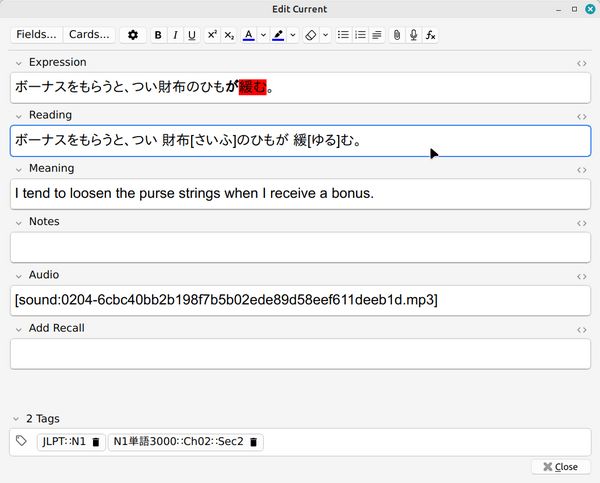
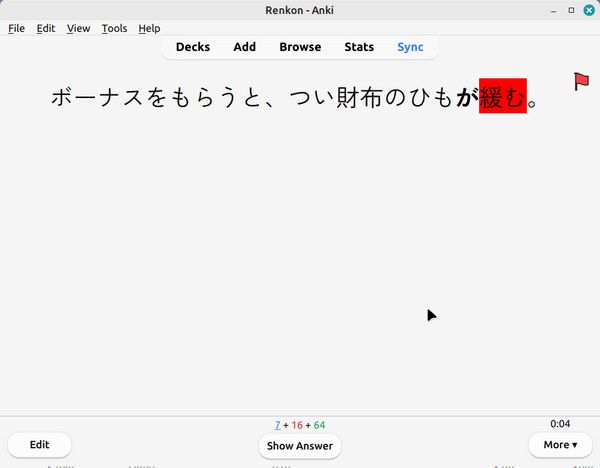

Pretty straightforward. Read what the front of the card says, pay special attention to the highlighted keyword. Flip to the back and see what it was. If you got the keyword reading and meaning correct but had trouble understanding the whole sentence, or struggled to remember the keyword, mark it as Hard. If you forgot the keyword, mark it as Again. Anything else is Good. (I only hit the Easy button if like… it is ridiculously easy. If it is so easy that I feel I don’t need to review it, I usually suspend or delete the card.
Vocab cards
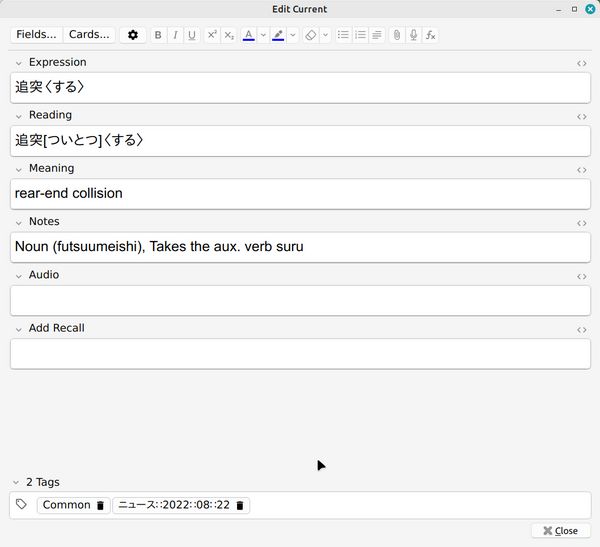
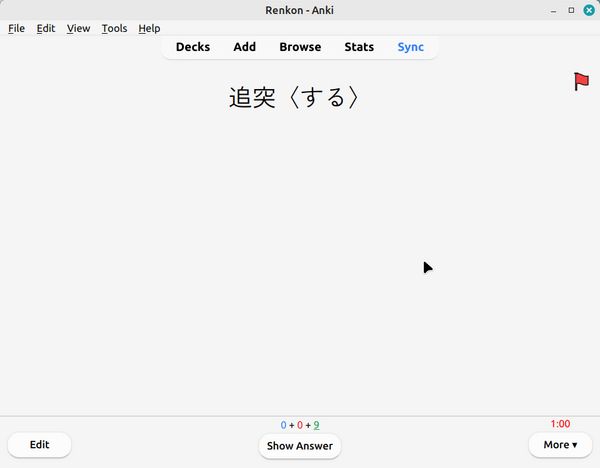
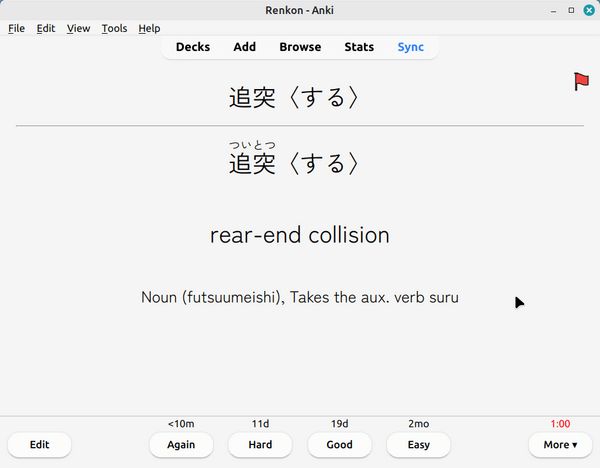
As I mentioned above, these days I tend to make lists of words I encounter in Takoboto and then import them into Anki rather than make these by hand.
Add images to your vocab notes
I highly recommend going to Google Image Search (or whatever your search engine of choice is these days) and pasting images into Anki if that helps you remember stuff. I have no idea what is “Japanese mustard spinach” but I do know that when I go to the supermarket and see this veggie I know oh okay, this is 小松菜, gotcha.
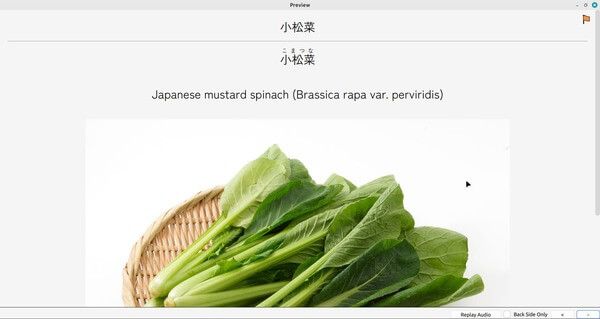
P.S. You can use the “optional recall” feature of Anki to easily make the reverse card (i.e. a card showing the pic and asking you for the Japanese name):
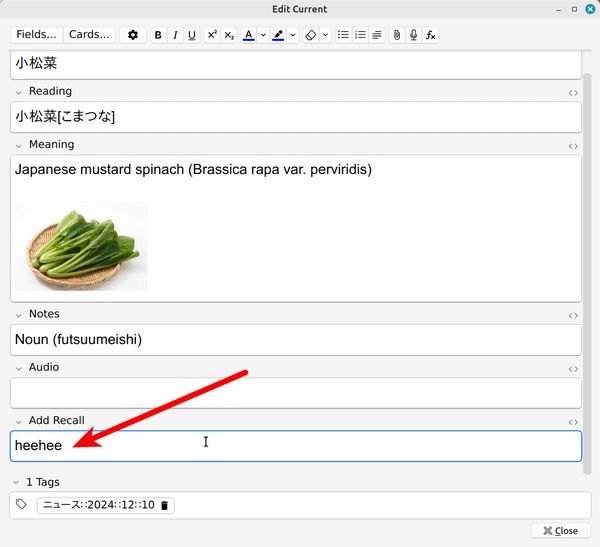
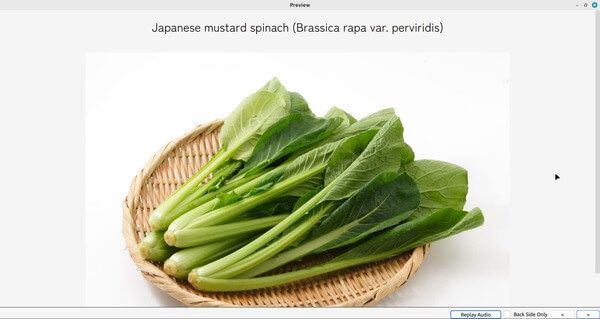
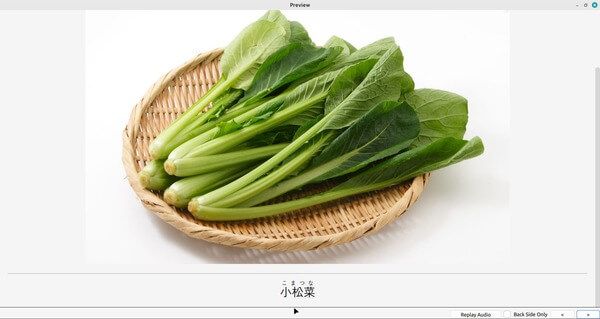
Cloze exercises
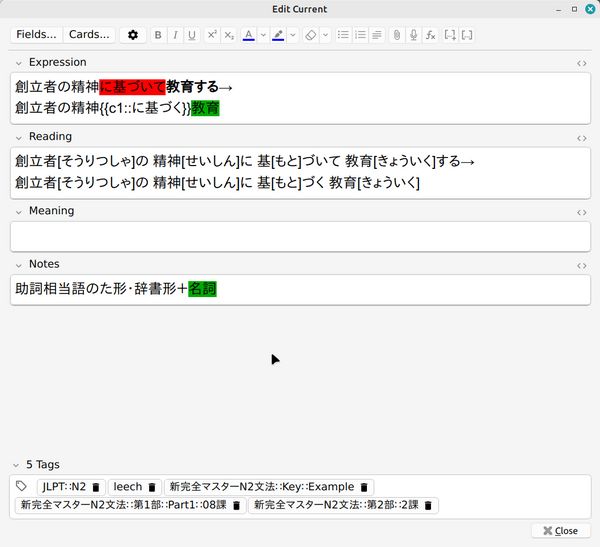
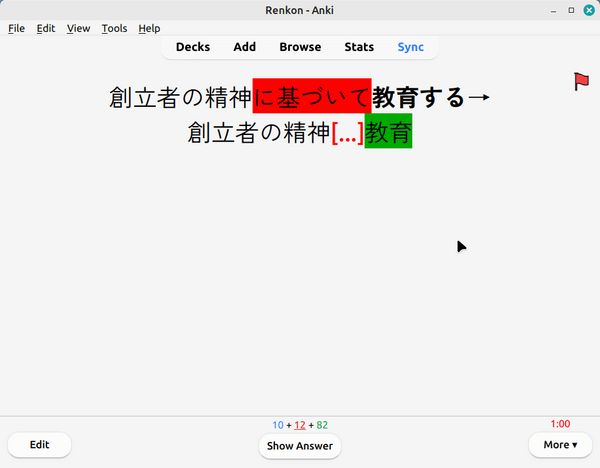
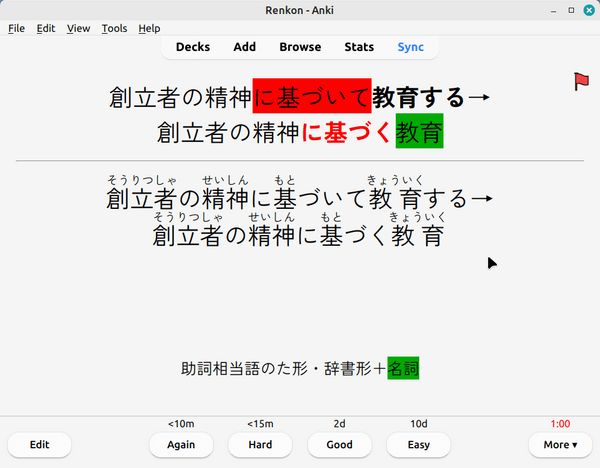
I made a separate guide for cloze deletions in my Anki tutorial because I think they’re wonderful. They’re great for fill-in-the-blank type questions where you don’t necessarily need to memorize something so much as test your knowledge of something, such as how to transform verbs, choosing the correct particle, that kind of thing.
Other stuff I’ve tried
The 日本語総まとめ Nihongo So-Matome series is a good alternative to the Shin Kanzen Master above if you prefer having English explanations. In my opinion, these books aren’t as useful since they’re a lot easier than official JLPT tests and might leave you unprepared. But if you are not terribly interested in actually taking the test, then these should be fine to get you started.
Just like Shin Kanzen Master, I recommend sticking to the Grammar and Reading books only. The reason why is because you are already learning kanji with RTK+KIC or whatever from Step 3, and vocab from your other sources. You can pick up the Listening book if you are studying specifically for JLPT, but otherwise I wouldn’t bother.
Shared Anki decks
I love Anki because it can be as simple or complex as you need it to be. I try to avoid using shared decks and just make my own cards. This is because 1) I don’t want to review EVERYTHING, just the words that give me trouble and 2) the makers of shared decks tend to put way too much info. I appreciate the effort but it can be a bit much sometimes.
THAT SAID, using shared decks is a perfectly fine way to cut down on time spent making cards. If for example you’re using Genki, there are plenty of decks like this one that other people made which you can simply download and import into your own collection, then edit as necessary.
The Most Important Thing Of All
…is to learn Japanese. NOT to craft the most perfect efficient matrix of studying and resources. However you are already studying is probably fine, and you do not need to overhaul your study schedule/regiment every time someone (even me!!) recommends a new method. There is no perfect method! And even if there were, who cares!! Your goal is to LEARN JAPANESE!!
I say this as someone who probably spent most of the past 15 years throwing everything out and starting from scratch, over and over again. Don’t do that! Just stick with it, add on with new resources and drop stuff that isn’t working for you, but don’t dump everything you’ve already got to start over from scratch. Your goal when setting up Anki should not be to own an immaculate collection of cards, it should be using it as a tool to LEARN JAPANESE. Don’t redo your entire collection because you thought of some better, more efficient way to organize your cards. Again: please learn from my mistakes!! 😭